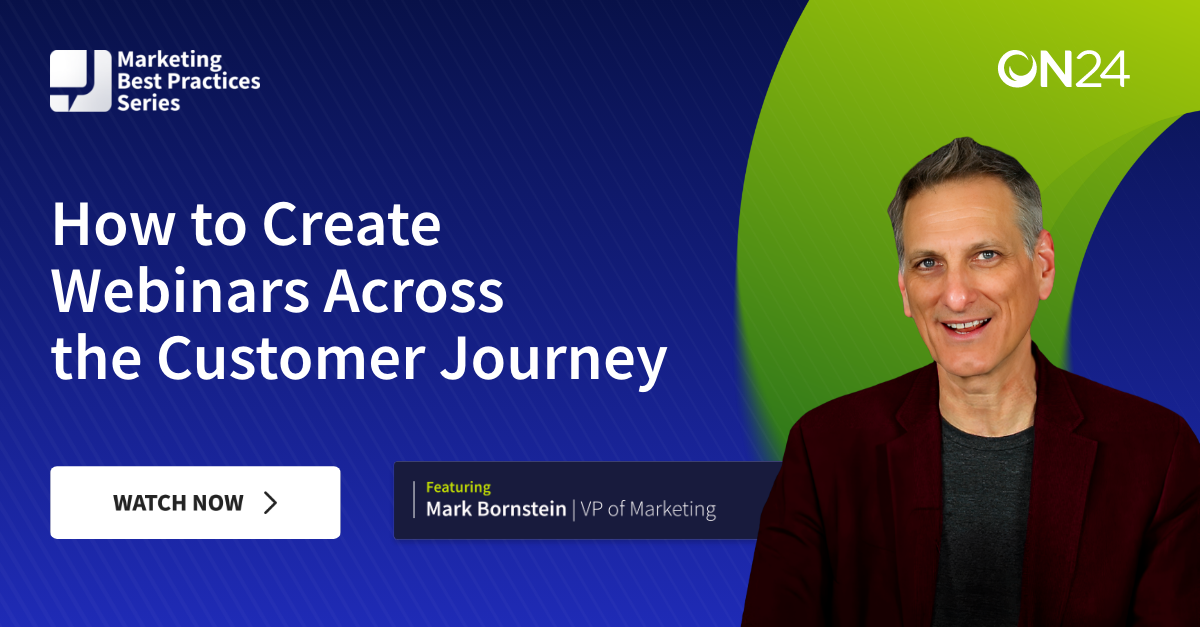Customer engagement is any interaction where a business connects with its audience to nurture and grow relationships. A good customer engagement program helps teams acquire and retain more customers, builds customer loyalty, and keeps businesses competitive in an increasingly competitive landscape.
But customer engagement demands more than the occasional phone call. New tactical approaches, like customer-centric webinars, combined with tried and true strategies, like NPS and data analytics, can drive dramatic business growth.
But how do you get from here to there? This guide will give you all the information you need. Read on to learn more.
Understanding Customer Engagement

Customer engagement is an important performance metric for practically all businesses. But, before you can work on improving it, it’s important to understand how it developed over time, what it really means and how it can be measured.
The Evolution of Customer Engagement
The nature of how customers engage with businesses has always been evolving, but the rapid rise of digital technology over the last three decades has drastically changed it.
Businesses can now interact with customers in various digital spaces, including websites and social media platforms — not to mention physical meet-ups. That means there are more opportunities for organizations to engage with customers than ever before, all able to be capitalized on with the right strategy.
Key Components of Customer Engagement
Customer engagement can be split into three main categories: cognitive, emotional, and behavioral. Each category represents the degree to which a customer is engaged with a business. Understanding each type is crucial in developing an effective engagement strategy.
Here’s the breakdown:
Cognitive engagement is the simplest type, referring to a customer’s brand or business awareness.
Emotional engagement refers to customers having an emotional response to a brand, like a feeling of inspiration or pride.
Behavioral engagement is when a customer directly interacts with a brand or business, whether that’s by consuming content or making a purchase.
Measuring Customer Engagement
While it’s possible to measure cognitive and emotional engagement by gathering customer feedback, businesses are generally most concerned with tracking behavioral engagement using statistical data. In a digital-first landscape, that’s made possible by all sorts of analytics tools.
Website data platforms like Google Analytics, proprietary social media analytics tools, and email marketing software can all measure engagement on different channels. Data from each source can then be combined into a central dashboard using solutions like the ON24 Intelligent Engagement Platform, providing a unified overview of customer engagement.
Developing a Customer Engagement Strategy

The best customer engagement strategies are developed intentionally rather than deployed on an ad hoc basis. Following these steps will help make sure you create a strategy that’s more likely to succeed.
Setting Clear Objectives
Define what you’re looking to achieve before developing your customer engagement strategy. Creating clear, measurable engagement objectives means you can align them with broader business goals, ensuring that your work contributes to overall performance.
To do this, consider how customer engagement ties into your business goals. If you want to grow your customer base, for example, then your objectives might be to secure higher search engine rankings and grow social media impressions to drive more website traffic and, ultimately, increase product demo signups.
Knowing Your Audience
Understanding your audience, including their demographics, interests and pain points is critical in developing a strategy to increase their engagement. Creating audience personas based on customer data is a great way to provide a simple overview of who you’re targeting.
These personas should include information about how each audience group interacts with your business and what type of content they’re most interested in. Insights like this will make it easier to develop an engagement strategy that suits their preferences.
Engagement Channels and Tactics
Digital engagement strategies can be deployed across diverse channels, spanning both traditional and digital. That includes social media, email, paid advertising, websites, in-store, print advertising and virtual events like webinars.
Given that 73% of customers use multiple channels during a typical buying journey, taking full advantage of every channel at your disposal is one of the best ways to boost the success of your engagement strategy.
Personalization is another key part of successfully improving customer engagement, ensuring that content is being delivered to the right people at the right time. And achieving personalization at scale is easier than ever thanks to AI-powered tools like the ON24 Analytics and Content Engine.
Crafting Your Customer Engagement Plan

Customer engagement strategies don’t exist in a vacuum — they should be considered an integral part of your broader business strategy. Here’s what you need to know to make sure they fit in.
Integration with Overall Marketing Strategy
Engagement is an important part of both customer acquisition and retention, so it’s essential to consider it throughout your entire marketing plan. Think about acquisition-focused and retention-focused engagement as two distinct but connected strategies.
The former should be oriented around increasing your business’s visibility to your target audience, aiming to boost awareness and grow a following. The latter should aim to keep current customers engaged with content that delivers consistent value, giving them a reason to stick around.
Budget Considerations
Accounting for engagement-focused activities in your overall marketing strategy primarily involves determining how much content you’ll need to produce. This is where the greatest investment will be needed in terms of time, with distribution and tracking both relatively lightweight in comparison.
Use insights from previous marketing campaigns to determine how long it takes to produce content that you’re likely to use in your engagement campaign and make sure you have enough resources to apply personalization techniques where required.
Customer Engagement Management

While the planning, setup and deployment phases of a customer engagement strategy are all important, some of the best results come from a sophisticated approach to managing the strategy. Use these tips to ensure effective management.
Tools and Technologies
Diverse tools can prove useful in planning, deploying, and tracking engagement strategies, including customer relationship management (CRM) and analytics platforms.
But pay most attention to the tools that can directly drive engagement. ON24 makes it simple to host live webinars, for example, offering the perfect opportunity to attract and engage your audience with powerful content.
Training and Empowering Your Team
Managing customer engagement strategies isn’t a one-person job, and typically involves multiple teams including marketing, customer support and sales. Creating a customer-centric culture throughout these teams can ensure that everybody is aligned, guaranteeing that your audience gets a consistent experience throughout their journey.
Share regular updates with relevant stakeholders as you plan and develop your engagement strategy. And make sure to feed results back to them, too, so everybody involved knows how well the strategy is performing and where it can be improved.
Feedback Loops and Continuous Improvement
New customer engagement strategies are unlikely to be perfect from day one, so it’s important to pay attention to customer feedback and data — information that can be fed back into your strategy to inspire improvements.
Adopting an iterative approach to managing your campaign, learning from feedback, and continuously revisiting your content and distribution strategy can help improve performance over time and generate more results that contribute to your business goals.
Customer Engagement Marketing

Building stronger relationships with customers is a great use for engagement marketing, helping to boost loyalty and increase customer lifetime value (CLV). These three tips will help you develop more successful customer engagement marketing strategies.
Create Engaging Content
Content is the cornerstone of customer engagement marketing, capturing and retaining audience attention. Most campaigns will use diverse content types, but they should all be focused around creating engaging experiences.
You can use many techniques to achieve this, including creating content based on your understanding of your customers’ main pain points, using effective hooks and adding interactive elements.
Leveraging Personalization for Engagement
Personalization is a powerful tool in boosting engagement, ensuring that each piece of content is relevant to its distributed audience. Creating personalized content experiences doesn’t just improve engagement; it can also strengthen brand loyalty.
The foundation for effective personalization is a segmentation strategy, grouping your customers into segments based on shared traits like interests or demographic details. You can then treat each of these segments as a separate sub-audience, targeting them with hyper-relevant content.
Innovative Engagement Techniques
As customer engagement becomes more critical to building and maintaining a loyal audience, an increasing number of tools and techniques designed specifically to boost engagement are emerging.
ON24 makes it easy to host virtual events, for example, providing a great way to connect with your audience and offering tools that simplify getting feedback or following up on potential leads.
Case Studies and Success Stories

A sophisticated engagement strategy, deployed successfully with the help of tools like ON24, can achieve diverse objectives.
UCB used ON24 to expand their webinar schedule and, combined with an omnichannel content strategy managed through our content hub tool, converted 30% of registrants to attendees, leading to a massive increase in audience engagement compared to their previous approach.
The team at Guardian Life Insurance used our platform to deliver a program of member engagement and partner enablement events, contributing to a 92% YOY revenue increase with $58MM of revenue attributed to ON24.
A new approach to customer engagement can generate transformational results that feed improved overall business performance. Assess your own strategy and take learnings from this guide to improve your results, or speak to an expert from ON24 today to learn how you can boost engagement across your audience.


